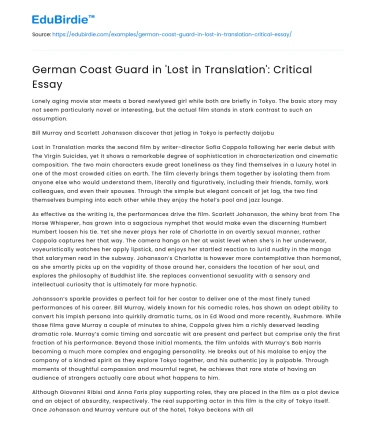Lonely aging movie star meets a bored newlywed girl while both are briefly in Tokyo. The basic story may not seem particularly novel or interesting, but the actual film stands in stark contrast to such an assumption.
Bill Murray and Scarlett Johansson discover that jetlag in Tokyo is perfectly daijobu
Save your time!
We can take care of your essay
- Proper editing and formatting
- Free revision, title page, and bibliography
- Flexible prices and money-back guarantee
Lost in Translation marks the second film by writer-director Sofia Coppola following her eerie debut with The Virgin Suicides, yet it shows a remarkable degree of sophistication in characterization and cinematic composition. The two main characters exude great loneliness as they find themselves in a luxury hotel in one of the most crowded cities on earth. The film cleverly brings them together by isolating them from anyone else who would understand them, literally and figuratively, including their friends, family, work colleagues, and even their spouses. Through the simple but elegant conceit of jet lag, the two find themselves bumping into each other while they enjoy the hotel’s pool and jazz lounge.
As effective as the writing is, the performances drive the film. Scarlett Johansson, the whiny brat from The Horse Whisperer, has grown into a sagacious nymphet that would make even the discerning Humbert Humbert loosen his tie. Yet she never plays her role of Charlotte in an overtly sexual manner, rather Coppola captures her that way. The camera hangs on her at waist level when she’s in her underwear, voyeuristically watches her apply lipstick, and enjoys her startled reaction to lurid nudity in the manga that salarymen read in the subway. Johansson’s Charlotte is however more contemplative than hormonal, as she smartly picks up on the vapidity of those around her, considers the location of her soul, and explores the philosophy of Buddhist life. She replaces conventional sexuality with a sensory and intellectual curiosity that is ultimately far more hypnotic.
Johansson’s sparkle provides a perfect foil for her costar to deliver one of the most finely tuned performances of his career. Bill Murray, widely known for his comedic roles, has shown an adept ability to convert his impish persona into quirkily dramatic turns, as in Ed Wood and more recently, Rushmore. While those films gave Murray a couple of minutes to shine, Coppola gives him a richly deserved leading dramatic role. Murray’s comic timing and sarcastic wit are present and perfect but comprise only the first fraction of his performance. Beyond those initial moments, the film unfolds with Murray’s Bob Harris becoming a much more complex and engaging personality. He breaks out of his malaise to enjoy the company of a kindred spirit as they explore Tokyo together, and his authentic joy is palpable. Through moments of thoughtful compassion and mournful regret, he achieves that rare state of having an audience of strangers actually care about what happens to him.
Although Giovanni Ribisi and Anna Faris play supporting roles, they are placed in the film as a plot device and an object of absurdity, respectively. The real supporting actor in this film is the city of Tokyo itself. Once Johansson and Murray venture out of the hotel, Tokyo beckons with all manner of unknown tastes and sights. Coppola showcases the dazzling video displays of Shibuya, films a surreal chase through a Pachinko parlor, and lets the strange familiarity of the science fiction world of modern Tokyo permeate her film. The city’s sheer alien beauty and vital pulse are certainly not lost on her, and the environment breathes more life into her story of lost souls than might that of a more occidental city.
Coppola also injects a self-conscious element into the film. “Every girl has a photography stage, where they take bad pictures of their feet,” says Johansson’s Charlotte. Spellbound viewers may recall a scene earlier in the film in which Coppola’s camera stays on Johansson’s feet for several seconds before panning up – suggesting that Coppola is telling us her own story through the filter of fiction. Coppola seems to enjoy this teasing, reflexive quality, which is becoming something of a trademark in light of the unexplained, removed perspective of The Virgin Suicides. Lost in Translation also has several unexplained moments, as hilarious Japanese dialogue goes untranslated, and a key conversation goes unheard. Yet while this methodology seems overextended and even mistaken in her earlier mystery, this through-the-looking-glass approach works surprisingly well in this film about searching and understanding.






 Stuck on your essay?
Stuck on your essay?

